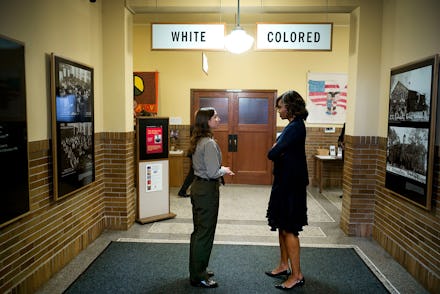The Most Powerful Political Photo of the Year Says a Lot About Modern America

The news: This might be the most politically loaded photo of the year.
Image Credit: Flickr
That's First Lady Michelle Obama (right) touring the Brown v. Board of Education National Historic Site in Topeka, Kansas.
When the picture was taken on May 16, it was almost 60 years to the day since the U.S. Supreme Court passed its decision desegregating the United States' public schools. But Obama's placement under the "colored" sign, with her Caucasian guide facing her under the "white" sign, is a potent reminder of how far we've actually come (or haven't come) toward realizing Brown's objectives.
It's not a pretty picture.
Consider this: Here's how segregated New York City's schools are today.
Image Credit: Huffington Post
The division is stark. In the vast majority of cases, the prevalence of black and Latino students directly corresponds to how high the school is rated on data aggregation site FindTheBest, while statistically, such schools are far more likely to receive "less experienced and less qualified teachers, high levels of teacher turnover, less successful peer groups, and inadequate facilities and learning materials" than their white counterparts.
The state also boasts the highest percentage of black and Latino students in schools with less than 10% white enrollment in the entire country.
But New York isn't alone. A 2014 study from UCLA's Civil Rights Project has determined that school segregation nationwide is at its highest level since 1968, despite gains made in the years immediately following Brown:
Image Credit: USA Today
As of 2012, these are the 20 states with the most segregated schools for black students:
Image Credit: USA Today
So what happened? The desegregation process was never simple.
Not only was it met with incredible resistance in many regions, it was rarely immune to the socioeconomic divisions wrought by housing segregation, job discrimination and a host of other factors that fuelled the maintenance of widespread racial inequality. School integration was most heavily enforced in the South, and as a result, that region maintains the least segregated schools in the country for black students.
But: Progress unraveled following the Board of Education of Oklahoma City v. Dowell Supreme Court decision in 1991, which set a national precedent for ending federal desegregation orders made under Brown. With no enforcement left, matters went from bad to worse. And in the wake of some massive demographic shifts, Latino students have also emerged as the most segregated minority today.
In an interview with USA Today, Civil Rights Project Director Gary Orfield affirmed that federal policy "didn't do much outside of the South, and we didn't do much for Latinos ever."
The numbers support his point: According to the Civil Rights Project report, over half of Latino students in California, Texas and New York attend schools that are 90% minority or more.
So: The erosion of gains made after Brown v. Board of Education should be the subject of serious national reckoning. Not only does our abandoned desegregation project confirm how divided American society still is, it also highlights the persistent inequalities still imposed on minority schools and neighborhoods throughout the country.
If we're truly committed to fixing this, it'll take more than simply turning a blind eye to the problem.
But for the time being, things aren't looking good.